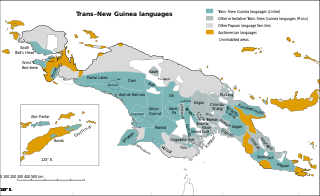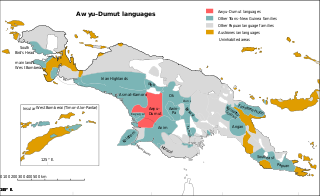Related Research Articles

Trans–New Guinea (TNG) is an extensive family of Papuan languages spoken on the island of New Guinea and neighboring islands ‒ corresponding to the country Papua New Guinea as well as parts of Indonesia.

The Papuan languages are the non-Austronesian and non-Australian languages spoken on the western Pacific island of New Guinea in Indonesia and Papua New Guinea, as well as neighbouring islands, by around 4 million people. It is a strictly geographical grouping, and does not imply a genetic relationship. The concept of Papuan (non-Austronesian) speaking Melanesians as distinct from Austronesian-speaking Melanesians was first suggested and named by Sidney Herbert Ray in 1892.
The East Papuan languages is a defunct proposal for a family of Papuan languages spoken on the islands to the east of New Guinea, including New Britain, New Ireland, Bougainville, Solomon Islands, and the Santa Cruz Islands. There is no evidence that these languages are related to each other, and the Santa Cruz languages are no longer recognized as Papuan.
Motu is a Central Papuan Tip language that is spoken by the Motuans, an indigenous ethnic group of Papua New Guinea. It is commonly used today in the region, particularly around the capital, Port Moresby.
East New Guinea Highlands is a 1960 proposal by Stephen Wurm for a family of Papuan languages spoken in Papua New Guinea that formed part of his 1975 expansion of Trans–New Guinea.
The Yuat languages are an independent family of five Papuan languages spoken along the Yuat River in East Sepik Province, Papua New Guinea. They are an independent family in the classification of Malcolm Ross, but are included in Stephen Wurm's Sepik–Ramu proposal. However, Foley and Ross could find no lexical or morphological evidence that they are related to the Sepik or Ramu languages.
Lungalunga, frequently though ambiguously called Minigir, is spoken by a small number of the Tolai people of Papua New Guinea, who live on the Gazelle Peninsula in East New Britain Province. It is often referred to in the linguistics literature as the Tolai "dialect" with an /s/.

The North Bougainville or West Bougainville languages are a small language family spoken on the island of Bougainville in Papua New Guinea. They were classified as East Papuan languages by Stephen Wurm, but this does not now seem tenable, and was abandoned in Ethnologue (2009).

The South Bougainville or East Bougainville languages are a small language family spoken on the island of Bougainville in Papua New Guinea. They were classified as East Papuan languages by Stephen Wurm, but this does not now seem tenable, and was abandoned in Ethnologue (2009).

Oksapmin is a Trans–New Guinea language spoken in Oksapmin Rural LLG, Telefomin District, Sandaun, Papua New Guinea. The two principal dialects are distinct enough to cause some problems with mutual intelligibility.

The Greater Awyu or Digul River languages, known in earlier classifications with more limited scope as Awyu–Dumut (Awyu–Ndumut), are a family of perhaps a dozen Trans–New Guinea languages spoken in eastern West Papua in the region of the Digul River. Six of the languages are sufficiently attested for a basic description; it is not clear how many of the additional names may be separate languages.

Fasu, also known as Namo Me, is one of the Kutubuan languages of New Guinea.

The Angan or Kratke Range languages are a family of the Trans–New Guinea languages in the classification of Malcolm Ross. The Angan languages are clearly valid as a family. They were first identified as such by J. Lloyd and A. Healey in 1968; Wurm (1975) classified them as Trans–New Guinea. Glottolog treats Angan as a separate or unclassified family, ignoring further evidence.

The Kainantu–Goroka languages are a family of Papuan languages established by Arthur Capell in 1948 under the name East Highlands. They formed the core of Stephen Wurm's 1960 East New Guinea Highlands family, and are one of the larger branches of Trans–New Guinea in the 2005 classification of Malcolm Ross.
Momuna (Momina), also known as Somahai, is a Papuan language spoken in the highlands of Papua province, Indonesia.
The Kwalean or Humene–Uare languages are a small family of Trans–New Guinea languages spoken in the "Bird's Tail" of New Guinea. They are classified within the Southeast Papuan branch of Trans–New Guinea.

The West Trans–New Guinea languages are a suggested linguistic linkage of Papuan languages, not well established as a group, proposed by Malcolm Ross in his 2005 classification of the Trans–New Guinea languages. Ross suspects they are an old dialect continuum, because they share numerous features that have not been traced to a single ancestor using comparative historical linguistics. The internal divisions of the languages are also unclear. William A. Foley considers the TNG identity of the Irian Highlands languages at least to be established.
The Orya–Tor languages are a family of just over a dozen Papuan languages spoken in Western New Guinea, Indonesia.
Molof is a poorly documented Papuan language spoken by about 200 people in Molof village, Senggi District, Keerom Regency.
Nii is a Trans–New Guinea language of the Chimbu–Wahgi branch spoken in the highlands of Papua New Guinea.
References
- 1 2 3 Kenati at Ethnologue (25th ed., 2022)
